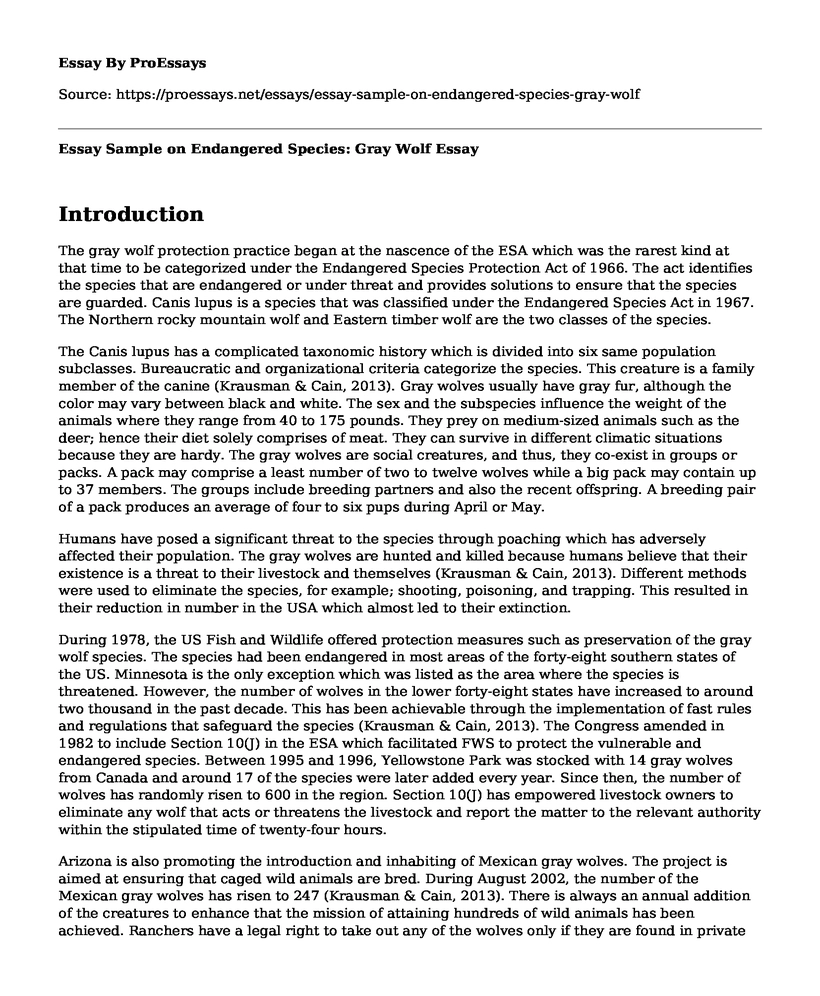Introduction
The gray wolf protection practice began at the nascence of the ESA which was the rarest kind at that time to be categorized under the Endangered Species Protection Act of 1966. The act identifies the species that are endangered or under threat and provides solutions to ensure that the species are guarded. Canis lupus is a species that was classified under the Endangered Species Act in 1967. The Northern rocky mountain wolf and Eastern timber wolf are the two classes of the species.
The Canis lupus has a complicated taxonomic history which is divided into six same population subclasses. Bureaucratic and organizational criteria categorize the species. This creature is a family member of the canine (Krausman & Cain, 2013). Gray wolves usually have gray fur, although the color may vary between black and white. The sex and the subspecies influence the weight of the animals where they range from 40 to 175 pounds. They prey on medium-sized animals such as the deer; hence their diet solely comprises of meat. They can survive in different climatic situations because they are hardy. The gray wolves are social creatures, and thus, they co-exist in groups or packs. A pack may comprise a least number of two to twelve wolves while a big pack may contain up to 37 members. The groups include breeding partners and also the recent offspring. A breeding pair of a pack produces an average of four to six pups during April or May.
Humans have posed a significant threat to the species through poaching which has adversely affected their population. The gray wolves are hunted and killed because humans believe that their existence is a threat to their livestock and themselves (Krausman & Cain, 2013). Different methods were used to eliminate the species, for example; shooting, poisoning, and trapping. This resulted in their reduction in number in the USA which almost led to their extinction.
During 1978, the US Fish and Wildlife offered protection measures such as preservation of the gray wolf species. The species had been endangered in most areas of the forty-eight southern states of the US. Minnesota is the only exception which was listed as the area where the species is threatened. However, the number of wolves in the lower forty-eight states have increased to around two thousand in the past decade. This has been achievable through the implementation of fast rules and regulations that safeguard the species (Krausman & Cain, 2013). The Congress amended in 1982 to include Section 10(J) in the ESA which facilitated FWS to protect the vulnerable and endangered species. Between 1995 and 1996, Yellowstone Park was stocked with 14 gray wolves from Canada and around 17 of the species were later added every year. Since then, the number of wolves has randomly risen to 600 in the region. Section 10(J) has empowered livestock owners to eliminate any wolf that acts or threatens the livestock and report the matter to the relevant authority within the stipulated time of twenty-four hours.
Arizona is also promoting the introduction and inhabiting of Mexican gray wolves. The project is aimed at ensuring that caged wild animals are bred. During August 2002, the number of the Mexican gray wolves has risen to 247 (Krausman & Cain, 2013). There is always an annual addition of the creatures to enhance that the mission of attaining hundreds of wild animals has been achieved. Ranchers have a legal right to take out any of the wolves only if they are found in private land and noted attacking livestock and other domestic animals.
Wisconsin DNR has played an essential role in creating awareness amongst the citizens and the community concerning the importance of tolerating the gray wolves. , and it is incorporated in the local areas. Thus, the agency helps to integrate the society in wolf management and to understand the importance of having the rare species in particular regions (Jachowski, Millspaugh, Angermeier, & Slotow, 2016). Section six of the ESA ensures that the federal government is involved in the wolf management so that the Service operates cohesively with the policies and agreements set up by the states.
Conclusion
The Service has played a significant role in ensuring that the wild animals are accepted by the people in the society, for example; implementation of projects that oversee that registered ranchers who have incurred livestock or domestic animals loss are well compensated (Jachowski et al., 2016). It has set up programs such as the Federal Wolf-livestock Demonstration Project. The Service has sought opinions concerning the Mexican wolf through the appointment of a team of eleven members, Mexican Wolf/Livestock Council which was formed in 2011. The council was made up of volunteers such as tribes, county representatives, ranchers, and environmental groups. The primary objective of this council was to develop a strategic plan aimed at handling the gray wolf-livestock disputes. The program contains three principal strategies: compensation for the presence of wolves, funding policies and measures set to avoid conflicts and subsidizing funds for damages caused by the wolves.
References
Jachowski, D., Millspaugh, J. J., Angermeier, P. L., &Slotow, R. H. (2016). Reintroduction of fish and wildlife population
Krausman, P. R., & Cain, J. W. (2013). Wildlife management and conservation: Contemporary principles and practices.
Cite this page
Essay Sample on Endangered Species: Gray Wolf. (2022, Oct 18). Retrieved from https://proessays.net/essays/essay-sample-on-endangered-species-gray-wolf
If you are the original author of this essay and no longer wish to have it published on the ProEssays website, please click below to request its removal:
- Women Should be Treated Equally
- Essay Sample - Air Pollution Toxicology
- Coalition for Human Immigration Rights of Los Angeles Paper Example
- Research Paper on Pediatric Obesity: Causes, Symptoms, Prevention and Treatment
- Critical Essay on Michael Harrington's: The Other America
- Article Analysis Essay on The Space Traders by Derrick Bell
- Human Trafficking: Exploitation of Millions Through Coercion and Fraud - Essay Sample







